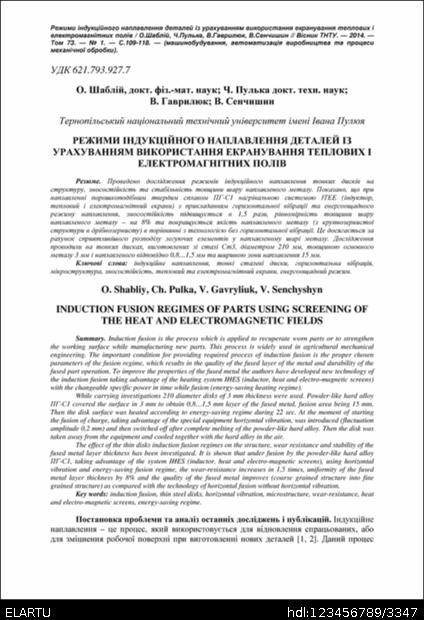Будь ласка, використовуйте цей ідентифікатор, щоб цитувати або посилатися на цей матеріал:
http://elartu.tntu.edu.ua/handle/123456789/3347

Повний запис метаданих
| Поле DC | Значення | Мова |
|---|---|---|
| dc.contributor.author | Пулька, Чеслав Вікторович | uk |
| dc.contributor.author | Гаврилюк, Володимир Ярославович | uk |
| dc.contributor.author | Сенчишин, Віктор Степанович | uk |
| dc.contributor.author | Shabliy, O. | uk |
| dc.contributor.author | Pulka, Ch. | uk |
| dc.contributor.author | Gavryliuk, V. | uk |
| dc.contributor.author | Senchyshyn, V. | uk |
| dc.date.accessioned | 2014-08-31T14:48:20Z | - |
| dc.date.available | 2014-08-31T14:48:20Z | - |
| dc.date.created | 2014-03-20 | uk |
| dc.date.issued | 2014-03-20 | uk |
| dc.identifier.citation | Режими індукційного наплавлення деталей із урахуванням використання екранування теплових і електромагнітних полів / О. Шаблій, Ч. Пулька, В. Гаврилюк, В. Сенчишин // Вісник ТНТУ — Тернопіль : ТНТУ, 2014. — Том 73. — № 1. — С 109-118. — (машинобудування, автоматизація виробництва та процеси механічної обробки). | uk |
| dc.identifier.citation | Induction fusion regimes of parts using screening of the heat and electromagnetic fields / O. Shabliy, Ch. Pulka, V. Gavryliuk, V. Senchyshyn // Bulletin of TNTU — Ternopil : TNTU, 2014. — Volume 73. — No 1. — P 109-118. — (engineering, factory automation and processes of mechanical treatment). | uk |
| dc.identifier.issn | 1727-7108 | - |
| dc.identifier.uri | http://elartu.tntu.edu.ua/handle/123456789/3347 | - |
| dc.description.abstract | Проведено дослідження режимів індукційного наплавлення тонких дисків на структуру, зносостійкість та стабільність товщини шару наплавленого металу. Показано, що при наплавленні порошкоподібним твердим сплавом ПГ-С1 нагрівальною системою ІТЕЕ (індуктор, тепловий і електромагнітний екрани) з прикладанням горизонтальної вібрації та енергоощадного режиму наплавлення, зносостійкість підвищується в 1,5 рази, рівномірність товщини шару наплавленого металу – на 8% та покращується якість наплавленого металу (з крупнозернистої структури в дрібнозернисту) в порівнянні з технологією без горизонтальної вібрації. Це досягається за рахунок сприятливішого розподілу легуючих елементів у наплавленому шарі металу. Дослідження проводили на тонких дисках, виготовлених зі сталі Ст3, діаметром 210 мм, товщиною основного металу 3 мм і наплавленого відповідно 0,8...1,5 мм та шириною зони наплавлення 15 мм. | uk |
| dc.description.abstract | Induction fusion is the process which is applied to recuperate worn parts or to strengthen the working surface while manufacturing new parts. This process is widely used in agricultural mechanical engineering. The important condition for providing required process of induction fusion is the proper chosen parameters of the fusion regime, which results in the quality of the fused layer of the metal and durability of the fused part operation. To improve the properties of the fused metal the authors have developed new technology of the induction fusion taking advantage of the heating system IHES (inductor, heat and electro-magnetic screens) with the changeable specific power in time while fusion (energy-saving heating regime). While carrying investigations 210 diameter disks of 3 mm thickness were used. Powder-like hard alloy ПГ-С1 covered the surface in 3 mm to obtain 0,8...1,5 mm layer of the fused metal, fusion area being 15 mm. Then the disk surface was heated according to energy-saving regime during 22 sec. At the moment of starting the fusion of charge, taking advantage of the special equipment horizontal vibration, was introduced (fluctuation amplitude 0,2 mm) and then switched off after complete melting of the powder-like hard alloy. Then the disk was taken away from the equipment and cooled together with the hard alloy in the air. The effect of the thin disks induction fusion regimes on the structure, wear resistance and stability of the fused metal layer thickness has been investigated. It is shown that under fusion by the powder-like hard alloy ПГ-С1, taking advantage of the system IHES (inductor, heat and electro-magnetic screens), using horizontal vibration and energy-saving fusion regime, the wear-resistance increases in 1,5 times, uniformity of the fused metal layer thickness by 8% and the quality of the fused metal improves (coarse grained structure into fine grained structure) as compared with the technology of horizontal fusion without horizontal vibration. | uk |
| dc.language.iso | uk | - |
| dc.publisher | Тернопільський національний технічний університет ім. Івана Пулюя | - |
| dc.subject | індукційне наплавлення | uk |
| dc.subject | тонкі сталеві диски | uk |
| dc.subject | горизонтальна вібрація | uk |
| dc.subject | мікроструктура | uk |
| dc.subject | зносостійкість | uk |
| dc.subject | тепловий та електромагнітний екрани | uk |
| dc.subject | енергоощадний режим | uk |
| dc.subject | induction fusion | uk |
| dc.subject | thin steel disks | uk |
| dc.subject | horizontal vibration | uk |
| dc.subject | microstructure | uk |
| dc.subject | wear-resistance | uk |
| dc.subject | heat and electro-magnetic screens | uk |
| dc.subject | energy-saving regime | uk |
| dc.title | Режими індукційного наплавлення деталей із урахуванням використання екранування теплових і електромагнітних полів | uk |
| dc.title.alternative | Induction fusion regimes of parts using screening of the heat and electromagnetic fields | uk |
| dc.type | Article | uk |
| dc.rights.holder | © „Вісник Тернопільського національного технічного університету“ | - |
| dc.coverage.placename | Тернопіль | uk |
| dc.status | Опубліковано раніше | - |
| dc.subject.udc | 621.793.927.7 | uk |
| Розташовується у зібраннях: | Вісник ТНТУ, 2014, № 1 (73) | |
Файли цього матеріалу:
| Файл | Опис | Розмір | Формат | |
|---|---|---|---|---|
| TNTUB_2014v73n1_O_Shabliy-Induction_fusion_regimes_109-118.pdf | 567,62 kB | Adobe PDF | Переглянути/відкрити | |
| TNTUB_2014v73n1_O_Shabliy-Induction_fusion_regimes_109-118.djvu | 523,46 kB | DjVu | Переглянути/відкрити | |
| TNTUB_2014v73n1_O_Shabliy-Induction_fusion_regimes_109-118__COVER.png | 197,79 kB | image/png | Переглянути/відкрити |
Усі матеріали в архіві електронних ресурсів захищені авторським правом, всі права збережені.